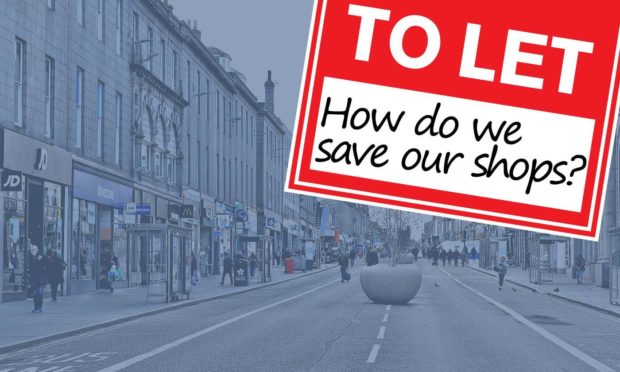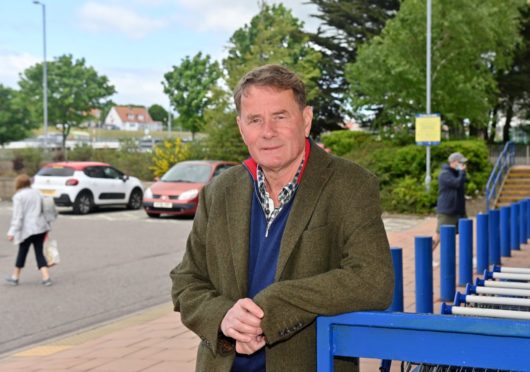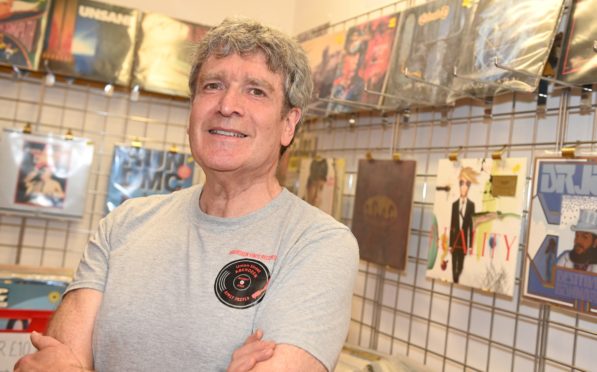The true scale of the crisis facing Aberdeen’s retail sector has been laid bare after it was confirmed the John Lewis department store will not reopen in the city centre.
Research carried out by Aberdeen Journals found there are currently 79 empty shops in the city centre.
Union Street alone has a total of 36 vacant units – including former bookmakers, cafes and travel shops.
There are also dozens of empty shops elsewhere, including in the Bon Accord, Trinity and Union Square shopping centres.
We conducted our research as it was confirmed John Lewis will not be reopening its store on George Street, while the Save the Children charity shop on Union Street became the latest casualty.
City ‘was already on brink’
Professor Andrew Turnbull, a retail expert from Robert Gordon University’s business school, believes retailers were already heading towards a precipice – but that has been accelerated by Covid-19.
Now high street firms are facing a fight to survive amidst an increase in online shopping and a fall in the number of people making their way into city centres.
“It’s a combination of population and geographical isolation,” he said.
“The footfall these major retailers need to justify their existence in the city and generate sufficient income just isn’t there.
“The actual sites are subject to problems with rent, wages and overheads. Online doesn’t help but they are also struggling with competition from out-of-town supermarkets for whom groceries represent a minority of turnover and profit.
“You only have to look at the likes of the Arcadia brands – the ownership of that now lies with Asos and Boohoo. They are perfectly happy to keep it online.
“The likes of John Lewis have had declining earnings and footfall for several years, even before Covid, and then we had the pandemic, so it is a perfect storm. All of that saw demand shifting to online.
“About 40 retailers over the last year have gone to bankruptcy. A lot of names have gone from the high street.”
Zoom in on our interactive map to see the full scale of the shop closures –
Aberdeen urged to follow Glasgow example
Bob Smith, the owner of Union Street shop Aberdeen Vinyl Records, believes Aberdeen should look to other Scottish cities for inspiration in a bid to attract more people back to the city centre.
“The example I always think of is Sauchiehall Street and Buchanan Street in Glasgow, because they have not just played with the idea of making it pedestrianised. It’s all properly paved and there’s no traffic.
“The example of Glasgow shows how it can end up. They have cafes, proper shops and a mixture of both.”
When we asked members of the public what they thought could be done to revitalise Aberdeen, suggestions included cleaning up buildings in the city centre and doing more to encourage independent businesses to take up empty retail units.
Watch as locals have their say on the way forward –
Despite the current situation looking bleak, Professor Turnbull says there are options available to turn the high street’s fortunes around and revitalise the city’s retail sector.
Those include a greater mix of shops, cafes and other outlets such as fitness centres, more collaboration between businesses and a greater focus on the “customer experience”, as well as more temporary shops.
Shops can ‘provide experience’
“What they have to do is meet shoppers’ expectations, specifically concerning convenience and value,” Prof Turnbull said.
“They need to stay ahead of the competition, and they need to offer an experience – something which makes it worth shoppers visiting. That may be the opportunity to take advantage of better deals, or they could branch out and offer things like kids’ play areas.
Prof Turnbull offers his thoughts in this video –
“It needs to be a personal service. People need to be made to feel very welcome and very important when they arrive.
“Empty spaces create negative morale and give entirely the wrong impression to potential retailers and customers.
“Pop-up retail is a short-term solution. Landlords who previously looked for someone to be in for five or 10 years will have to look for someone to take it for a month or three months.”
Sector ‘must be proactive’
“These places could be considered cultural or entertainment spaces,” Prof Turnbull added.
“In the same way Edinburgh has the festival, Aberdeen could look at having a seasonal focus at different times of the year.
“To attract people, you need to be proactive, creative and aware of current trends so you’re ahead of the game.
“Customers need to be rewarded for returning to the same place. That way they can compete with online shopping more effectively.
“Although the big retailers need to rationalise their footprint, they nevertheless need to create an experience. They need to be inventive.
“Café culture is something people are familiar with from foreign travel and has become more attractive.”
What can be done to stave off further decline?
Adrian Watson, the chief executive of business improvement district Aberdeen Inspired, believes a move towards online shopping has impacted the high street.
In order to arrest the flow of businesses choosing to pull out of the city centre, Mr Watson wants a review of the current business rates system.
“Filling vacant units in the city centre is a fluid process and the number of empty units can vary, for a variety of complex reasons,” Mr Watson added.
“We work hard with our partners, including the city council and the shopping centres, to try to reduce the number of vacant spaces as part of our commitment to maintaining a vibrant city centre.
“But the solution is a mix of tactics which needs both public and private investment as well as a joined-up approach.
“As a priority, we are pushing for a review of business rates, which are currently based on bricks and mortar – the size of the building. This is an antiquated system we want to see replaced with a fairer system.”
Scott Begbie: Cafe culture is the way to bring Aberdeen city centre back to life












